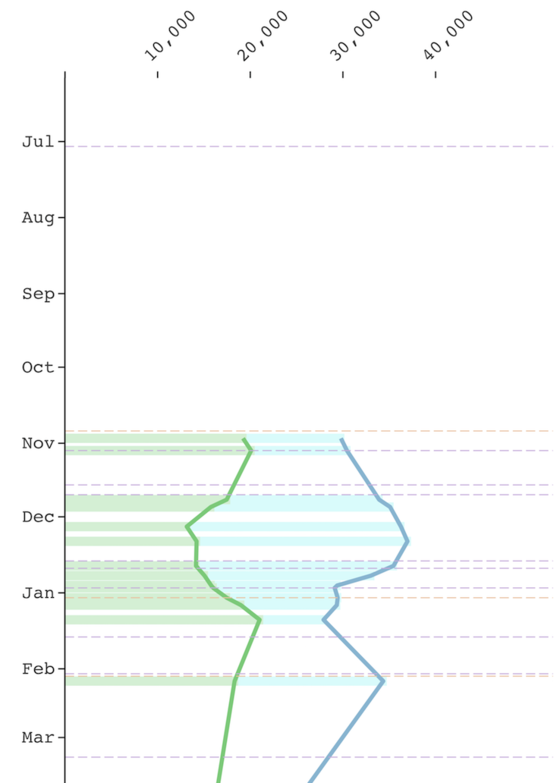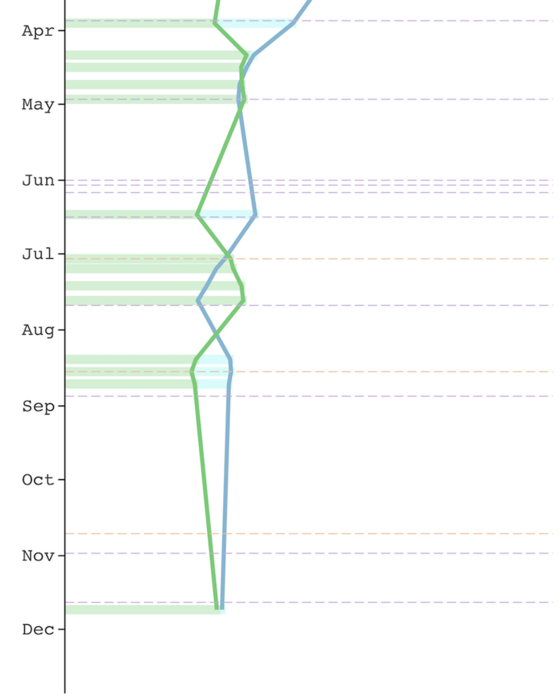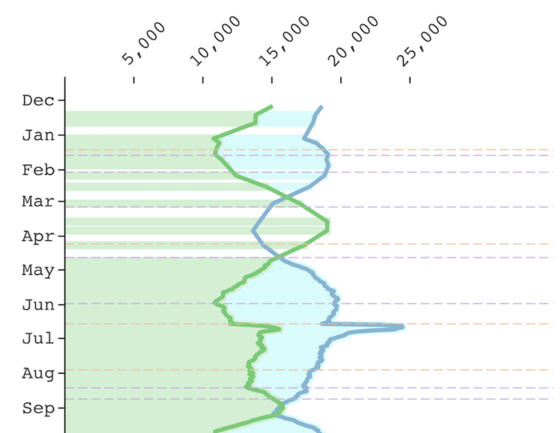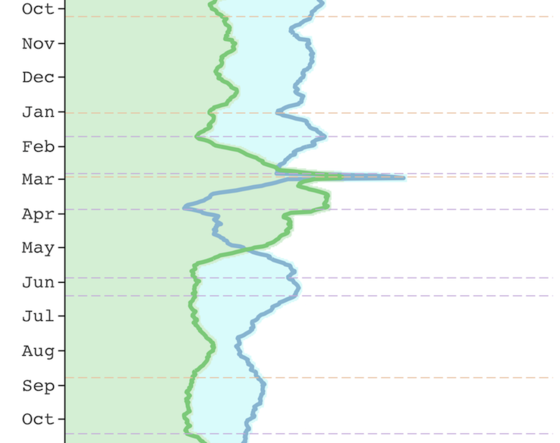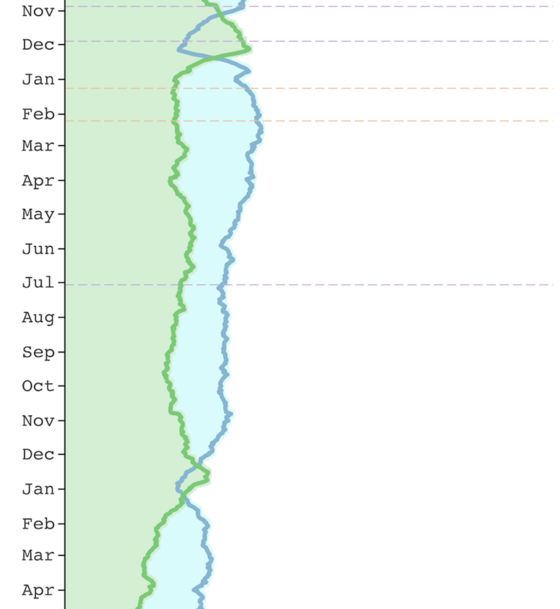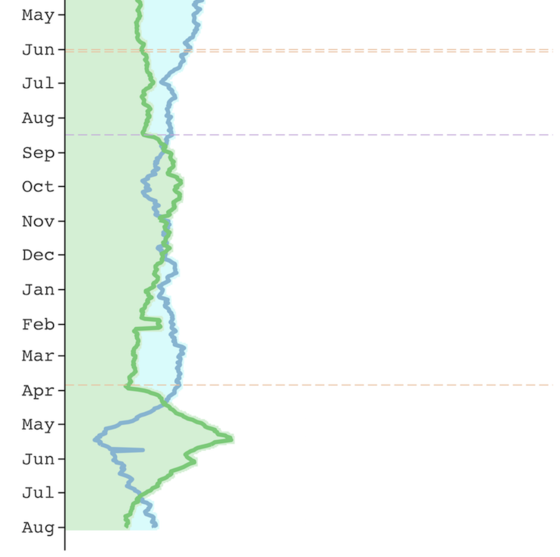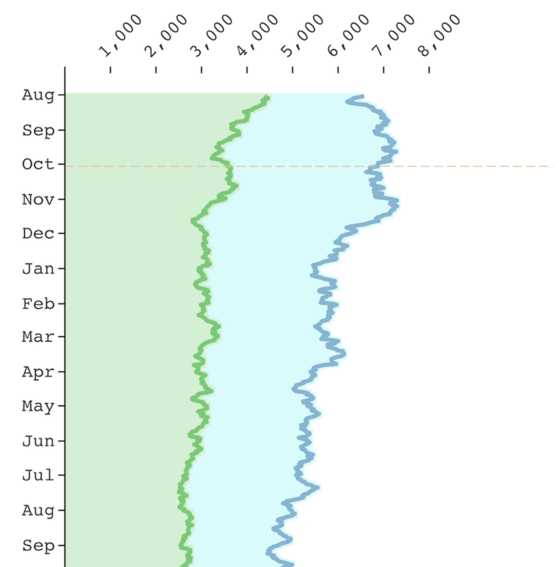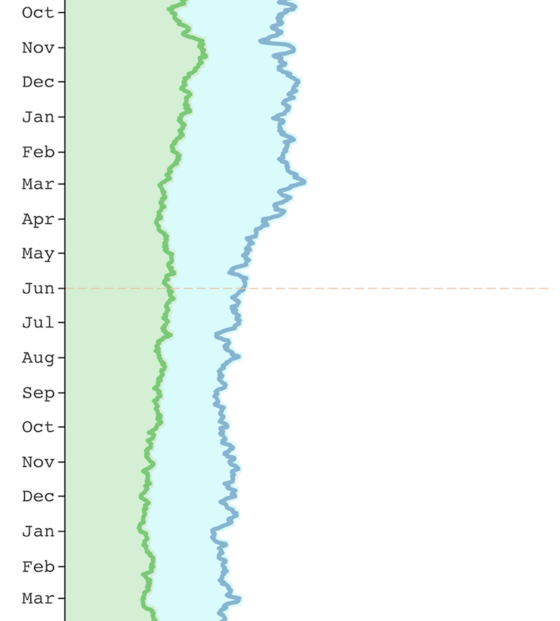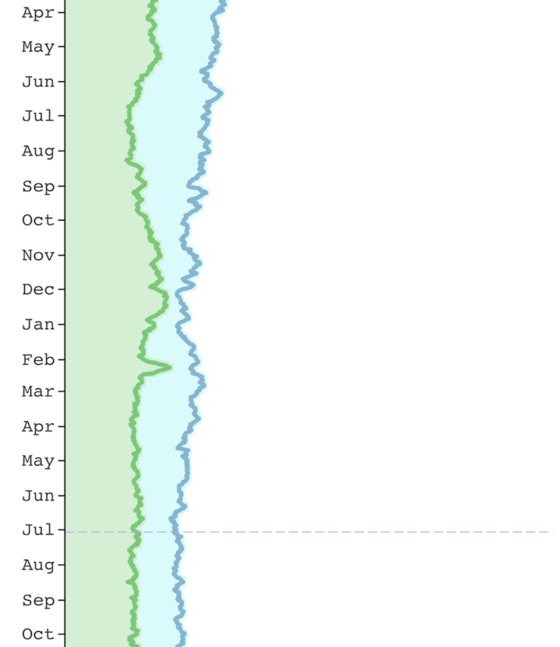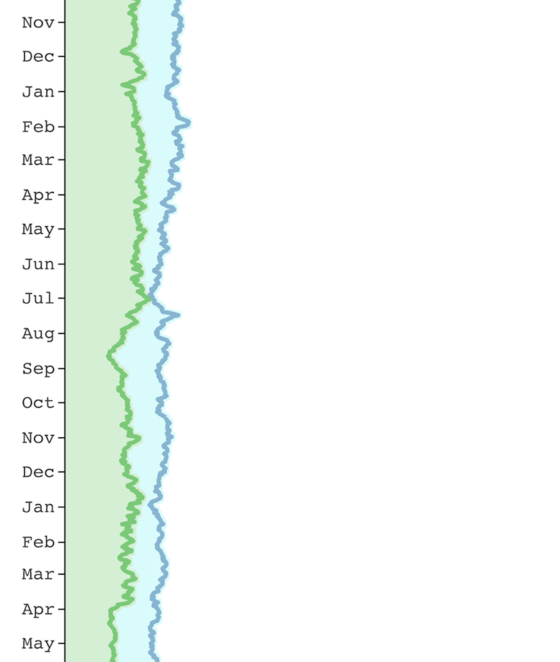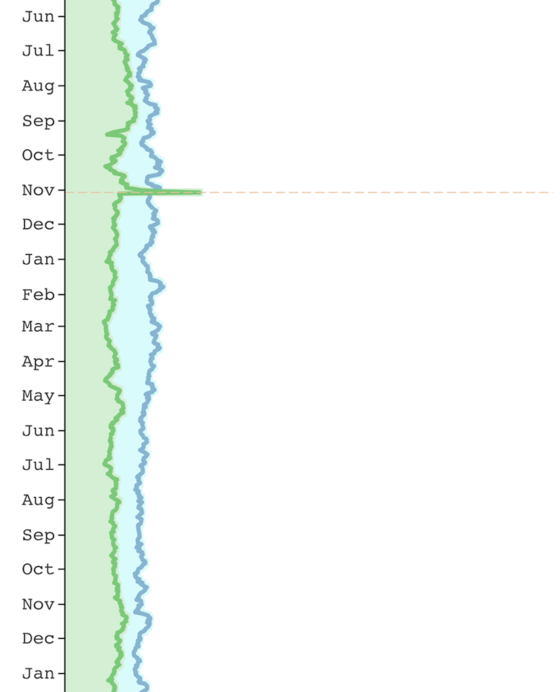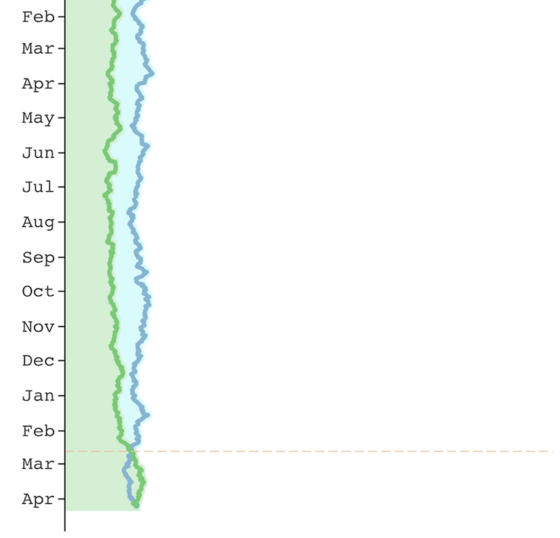User:A Helpful Little Gnome/Sandbox899: Difference between revisions
mNo edit summary |
(temp deleting the TOC b/c it's really hard to edit with it) |
||
| Line 1: | Line 1: | ||
[toc] | |||
{| | {| | ||
| width="40px" style="border-right:solid 1px darkslategrey;color:white" | ........... || style='padding-left:10px' | [[File:Survivor-Zombie Ratio.png]] | | width="40px" style="border-right:solid 1px darkslategrey;color:white" | ........... || style='padding-left:10px' | [[File:Survivor-Zombie Ratio.png]] | ||
<center> | |||
<div style="width:600px;text-align:left"> | |||
<big>'''The Survivor / Zombie Ratio, December 2005 to April 2020.'''</big><br> | |||
The Y axis shows the ratio of survivors to zombies, with the dashed horizontal line at 1:1 indicating an equal number of survivors to zombies. Above the line favours survivors (e.g., 2:1 means two survivors for every one zombie). Below the line favours zombies. The tick marks on the X axis indicate the start of the year named below. At each time point (day), the ratio is the number of survivors divided by the number of zombies, collected at the 0:00 hour of the day.<sup>1</sup> The extra info on either side of the dashed horizontal line has some caveats.<sup>2</sup> | |||
Data from [http://www.urbandead.com/stats.csv Urban Dead statistics], April 2017 to current day. Older data from the [[Wikipedia:Wayback Machine|Wayback Machine]] was collected manually.<sup>3</sup> | |||
</div> | |||
</center> | |||
this page | |||
<Big><big><big>'''INTERPRETING THE GRAPHS'''</BIG></big></big> | |||
The first graph is the snapshot and to-the-point. The graph below comes in three parts and goes more in-depth, listing most game updates and a small number of player-initiated events. While the game updates are listed regardless of their impact on the survivor-zombie ratio, partly due to the relative infrequency of game updates, the player events are (usually) listed if they seem to be responsible for a shift in the survivor-zombie ratio. | |||
Although often it seems "obvious" that a game update or player event caused a shift in the ratio, it is difficult or impossible to identify every player event or attribute a single update or event when multiples exist at the same time. There is much we don't know. Sometimes, however, an event will be so large as [[March of The Dead 2|so large]] that it is undeniable that it caused a change in the ratio. | |||
That said, '''the purpose of the following in-depth graph is to chronicle the game balance over the years, without pointing too many fingers.''' | |||
blah blah blah common philosophies... | |||
*'''Equal numbers of zombies and survivors'''. | |||
*'''Zombies heavily outnumber survivors'''. | |||
*'''Let it be (Laissez-faire)'''. | |||
{| style = 'padding-left:50px' | |||
|- | |||
|<big><big>CAVEATS</big></big> | |||
<sup>1</sup> Urban Dead's statistics updates its data on every hour of the day, yet characters only seem to [[idle|idle out]] on the 00:00 hour of the day. This creates a "climbing" effect where the data increases throughout the day until it hits the 00:00 mark and drops. For simplicity, data from other timepoints were excluded. (Note that the Urban Dead statistics page missed its mark a few times, and thus on certain days the data was collected on the 00:01 and 0:02 timepoints.) | |||
<sup>2</sup> The percentage of days favouring either survivors or zombies was calculated by counting out the days when the ratio was above or below 1. The ratio never equals exactly 1, at least for the data shown here (see Caveat 1). To calculate the average ratio when the game favoured either survivors or zombies, the data was cut into two parts: one with the ratio above 1 (survivor favoured) and the other with the ratio below 1 (zombie favoured). Keep in mind, error exists because the data is sporadic before April 2007 (see Caveat 3). | |||
<sup>3</sup> The graphs on this page only contain 28 data points before late April 2007 and 4,732 points afterward. You can see the effect this has on the graph of the Survivor-Zombie Ratio due to the oddly straight lines, as opposed to the "noisy" line thereafter. On the in-depth graph below, all the columns of white space are locations of missing data. When calculating the facts discussed in Caveat 2, the results heavily weigh the graph later than April 2007; there's simply more data there that "drowns out" the scant data before it. Thus, these facts are an approximation. | |||
One final caveat: this page is mostly the opinion of [[User:A Helpful Little Gnome|one person]]. While he has played the game almost continuously since September 2006 and paid attention to popular opinion, any analysis beyond the strictly factual has an incomplete perspective and its own, specific interpretation. | |||
|} | |||
{| style = 'padding-left:50px' | |||
|- | |||
|<big><big>WHY ISN'T [INSERT EVENT HERE] ON THE GRAPH?</big></big> | |||
It's possible that I missed an important game event (and it should be included). It's also important to reduce the number of events and game updates on the page. Some of the simpler or cosmetic game updates are not mentioned, such as bug fixes, server upgrades, and unofficial changes ([[News/2005#December_18|example]]). | |||
|} | |||
Revision as of 04:11, 2 June 2020
[toc]
| ........... | 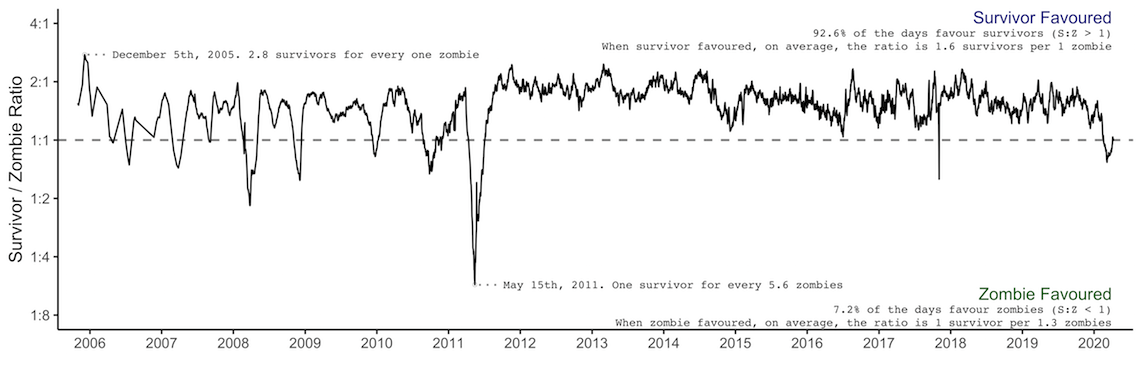
The Survivor / Zombie Ratio, December 2005 to April 2020. Data from Urban Dead statistics, April 2017 to current day. Older data from the Wayback Machine was collected manually.3
The first graph is the snapshot and to-the-point. The graph below comes in three parts and goes more in-depth, listing most game updates and a small number of player-initiated events. While the game updates are listed regardless of their impact on the survivor-zombie ratio, partly due to the relative infrequency of game updates, the player events are (usually) listed if they seem to be responsible for a shift in the survivor-zombie ratio. Although often it seems "obvious" that a game update or player event caused a shift in the ratio, it is difficult or impossible to identify every player event or attribute a single update or event when multiples exist at the same time. There is much we don't know. Sometimes, however, an event will be so large as so large that it is undeniable that it caused a change in the ratio. That said, the purpose of the following in-depth graph is to chronicle the game balance over the years, without pointing too many fingers. blah blah blah common philosophies...
EARLY DAY VOLATILITY This period is characterized by...
|
